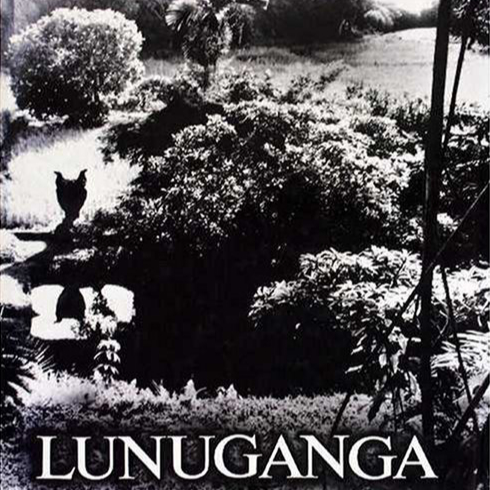Lunuganga
LunugangaGeoffrey BawaMarshall Cavendish Editions, 2006Hardcover | 10-1/2 x 12 inches | 220 pages | English | ISBN: 978-9812618443PUBLISHER'S DESCRIPTION: Lunuganga is considered today, as being one of the great private gardens of the Twentieth century. It is now administered by the Lunuganga Trust and can be visited by prior appointment. Lunuganga, is the enchanting creation of the Sri Lankan architect Geoffrey Bawa. He transformed an abandoned rubber estate in Southwest Sri Lanka, and created a series of carefully orchestrated, mystical gardens - a place of varying moods and sensations. This book contains a series of stunning black and white photographs, taken by two of Bawa's closest friends - Christoph Bon and Dominic Sansoni. The text in the book is by Geoffrey Bawa himself, offering an exciting insight into this charismatic architect's innovative way of thinking. Geoffrey Bawa was born in Sri Lanka in 1919. In a career which spanned four decades he built such memorable projects as the Sri Lanka Parliament at Kotte, the Ruhunu University Campus and the Kandalama Hotel, establishing himself as one of the most important Asian architects of his generation. Geoffrey Bawa died in 2003 after a long illness and his ashes were scattered on the Cinnamon Hill at the heart of the garden which he had fashioned for over 50 years. REFERRAL LINKS: dDAB COMMENTARY: In my recent review of photographer Giovanna Silva's new book, Mr. Bawa I Presume, I mentioned two main projects by Sri Lankan architect Geoffrey Bawa (1919-2003): Lunuganga, the 25-acre estate he started shaping in 1947; and Kandalama Hotel, completed nearly 50 years later, when Bawa was "in retirement." The latter masterpiece is one of the 100 buildings in my book 100 Years, 100 Buildings, while the former one is featured in 100 Years, 100 Landscape Designs. When it came time to research and write about Lunuganga, I'm glad I had been able to find a used copy — relatively cheaply, compared to the hundreds it goes for online — of the eponymous monograph on the project, first published in Singapore in 1990 and then released more widely by Marshall Cavendish Editions in 2006. No other document delves so deeply into the highly personal place. Lunuganga is a beautiful book that uses photographs, drawings, and text to transport readers to Bawa's compound on the edge of Dedduwa Lake. The first, the photographs, are by Christoph Bon with assistance by Dominic Sansoni. Bon, a contemporary of Bawa's, was born and educated in Switzerland and was a founding partner of Chamberlin, Powell and Bon, the British firm best known for the design of the Barbican Estate. Bon and Jean Chamberlin (the widow of Joe Chamberlin, who died in 1978) visited Lunuganga many times after meeting Bawa in 1976, eventually persuading him to publish a book on it. The duotone photographs, large on the page, emphasize the qualities of light and shade in the house and landscape. The photos range from details — be it a gnarly trunk, shapely leaves, or a stone finial — to expansive views, many of them on the banks of the lake. I'm guessing that, for most people, the photographs are the main draw of the book. But getting one's bearing with just the photos is difficult, so the drawings by artist Laki Senenayake and architect Sumangala Jayatilleke are extremely helpful — and as beautiful as the photos. The first pair of drawings (first spread below) situates Bawa's estate in Sri Lanka, while each of the seven chapters that follow focuses on a different part of the house and property. Each area is given an overall plan spread across two pages (third spread), with a thickened border and numbered key highlighting the area in that chapter. Other drawings appear here and there, such as a floor plan of the house (fourth spread) or sections through the buildings and the terraced landscape; all are valuable in learning about the place. The last of the three elements in the book is Bawa's text, which consists of a five-page introductory chapter and brief one-page descriptions for the seven chapters. The texts read like a guide to the garden, the author leading the reader up and down the different levels and along the walks, lawns, rice fields, and other parts of the landscape. Given that the gardens are open to the public and the buildings are run as a country house hotel, this book would be a fitting companion to an actual visit. There, Bawa's spirit must be strong, as after his death in 2003 his ashes were scattered from the summit of Cinnamon Hill, fusing garden and creator. SPREADS:

Geoffrey Bawa
Marshall Cavendish Editions, 2006
Hardcover | 10-1/2 x 12 inches | 220 pages | English | ISBN: 978-9812618443
PUBLISHER'S DESCRIPTION:
REFERRAL LINKS:
SPREADS:









